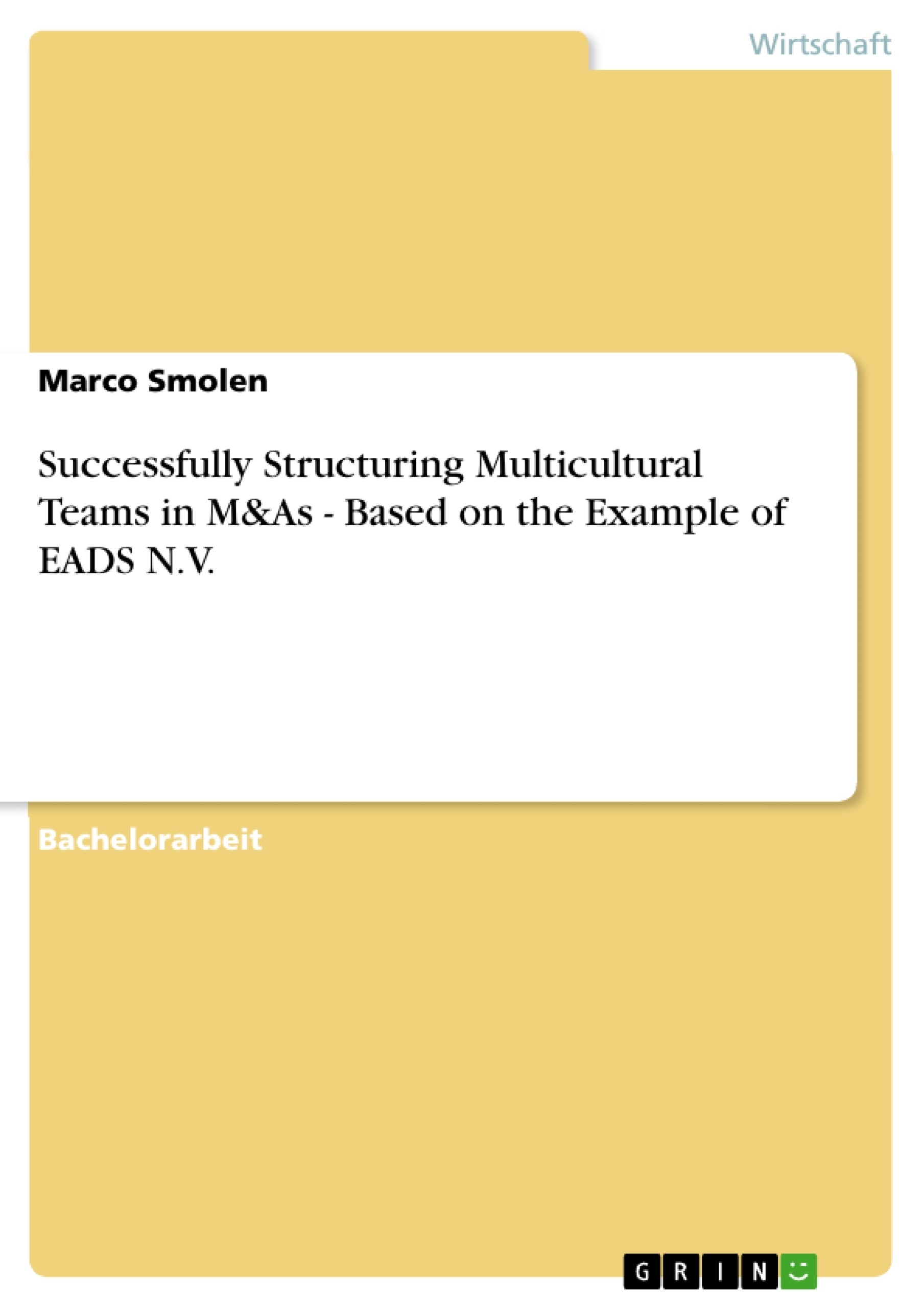
Successfully Structuring Multicultural Teams in M&As - Based on the Example of EADS N.V.
Bachelorarbeit, 2006
105 Seiten, Note: 1,7
Leseprobe
Inhaltsverzeichnis
- Preface
- Content
- List of Abbreviations
- List of Tables and Figures
- 1 Introduction
- 1.1 Executive Summary
- 1.2 Scope of Work
- 2 Problem
- 2.1 Definition of Problem
- 2.1.1 The need for Teams in a Merger or Acquisition
- 2.1.2 Cross-Cultural Challenges in Teams
- 2.1.3 Team Effectiveness
- 2.2 Reasoning and Motivation
- 2.3 Research Methods
- 2.1 Definition of Problem
- 3 Relevant Theories
- 3.1 Mergers and Acquisitions
- 3.1.1 Definition, Types, and Phases
- 3.1.2 Theories for Mergers and Acquisitions
- 3.1.2.1 Transaction Cost Theory
- 3.1.2.2 Agency Theory
- 3.1.2.3 Strategy
- 3.1.2.3.1 Resource-based View
- 3.1.2.3.2 Knowledge-based View
- 3.2 Culture
- 3.2.1 Definition
- 3.2.2 Theories for Culture
- 3.2.2.1 Kluckhohn / Strodtbeck
- 3.2.2.2 Hall
- 3.2.2.3 Hofstede
- 3.2.2.4 Trompenaars
- 3.2.2.5 Dülfer
- 3.2.2.6 GLOBE
- 3.3 Leadership
- 3.3.1 Definition and Approaches
- 3.3.2 Theories for Leadership
- 3.3.2.1 Blake and Mouton's Managerial Grid Model
- 3.3.2.2 Lewin's Leadership Styles
- 3.3.2.3 Likert's Leadership Styles
- 3.3.2.4 French and Raven Power Taxonomy
- 3.3.2.5 Social Exchange Theory
- 3.3.2.6 Strategic Contingencies Theory
- 3.3.2.7 Fiedler's Contingency Model
- 3.3.2.8 House's Path-Goal Theory
- 3.3.2.9 Vroom-Yetton / Vroom-Jago Model
- 3.4 Teams
- 3.4.1 Definition
- 3.4.2 Theories for Teams
- 3.4.2.1 Tuckman's Model of Group Development
- 3.4.2.2 Gersick's Punctuated Equilibrium Model
- 3.4.2.3 Belbin's Team Roles
- 3.4.2.4 Hackman's Team Effectiveness Model
- 3.4.2.5 Guzzo & Shea's Team Effectiveness Model
- 4 Selected Theory Elements
- 4.1 Geert Hofstede's Culture Value Dimensions
- 4.1.1 Power Distance
- 4.1.2 Individualism versus Collectivism
- 4.1.3 Masculinity versus Femininity
- 4.1.4 Uncertainty Avoidance
- 4.1.5 Long-Term versus Short-Term Orientation
- 4.2 Likert's Leadership Styles
- 4.2.1 Exploitative Authoritative
- 4.2.2 Benevolent Authoritative
- 4.2.3 Consultative
- 4.2.4 Participative
- 4.3 Hackman's Team Effectiveness Model
- 4.3.1 Real Team
- 4.3.2 Compelling Direction
- 4.3.3 Enabling Structure
- 4.3.4 Supportive Organizational Context
- 4.3.5 Expert Coaching
- 4.1 Geert Hofstede's Culture Value Dimensions
- 5 Case - European Aeronautic Defence and Space Company N.V.
- 5.1 The Multinational Merger of EADS
- 5.1.1 About EADS
- 5.1.2 The Merger in 2000
- 5.2 Application of Selected Theory Elements
- 5.2.1 Hofstede's Culture Value Dimensions
- 5.2.1.1 French Culture
- 5.2.1.2 German Culture
- 5.2.1.3 Spanish Culture
- 5.2.2 Likert- Leadership Styles
- 5.2.3 Hackman's Team Effectiveness Model
- 5.2.1 Hofstede's Culture Value Dimensions
- 5.3 Findings and Interpretation of Expert Interviews
- 5.3.1 Culture
- 5.3.2 Leadership
- 5.3.3 Teams
- 5.4 Solution of Case Problem
- 5.1 The Multinational Merger of EADS
- 6 Conclusion / Critical Comments / Outlook
Zielsetzung und Themenschwerpunkte
Die vorliegende Bachelorarbeit untersucht die Auswirkungen kultureller Diversität auf Teams in Fusionen und Übernahmen. Die Arbeit basiert auf dem Beispiel von EADS N.V. und zielt darauf ab, die Herausforderungen und Chancen der Zusammenarbeit in multinationalen Teams in diesem Kontext zu analysieren.
- Kulturelle Diversität in multinationalen Teams
- Theorien zu Fusionen und Übernahmen
- Theorien zu Kultur und Führung
- Team-Effektivität in multinationalen Kontexten
- Fallstudie EADS N.V. und Analyse der kulturellen Dimensionen, Führungsstile und Teamarbeit
Zusammenfassung der Kapitel
Das erste Kapitel bietet eine Einleitung in das Thema und stellt den Forschungsrahmen vor. Kapitel 2 definiert das Problem der kulturellen Diversität in Teams bei Fusionen und Übernahmen, beleuchtet die Motivation für die Forschung und beschreibt die angewendeten Methoden. Kapitel 3 präsentiert relevante Theorien zu Fusionen und Übernahmen, Kultur, Führung und Teamarbeit. Kapitel 4 greift ausgewählte Elemente aus den Theorien auf, um die Analyse in Kapitel 5 zu ermöglichen. Kapitel 5 fokussiert auf die Fallstudie EADS N.V. und analysiert die kulturellen Dimensionen, Führungsstile und Teamarbeit anhand der ausgewählten Theorien.
Schlüsselwörter
Die Arbeit konzentriert sich auf die Themenbereiche kulturelle Diversität, Fusionen und Übernahmen, multinationales Teamwork, Team-Effektivität, Führungsstile, Kulturdimensionen und die Fallstudie EADS N.V. Sie beschäftigt sich mit Theorien von Hofstede, Likert und Hackman sowie relevanten Ansätzen zur Analyse der Zusammenhänge zwischen Kultur, Führung und Teamarbeit in multinationalen Kontexten.
- 3.1 Mergers and Acquisitions
Details
- Titel
- Successfully Structuring Multicultural Teams in M&As - Based on the Example of EADS N.V.
- Hochschule
- FOM Essen, Hochschule für Oekonomie & Management gemeinnützige GmbH, Hochschulleitung Essen früher Fachhochschule
- Note
- 1,7
- Autor
- Marco Smolen (Autor:in)
- Erscheinungsjahr
- 2006
- Seiten
- 105
- Katalognummer
- V57468
- ISBN (eBook)
- 9783638519229
- ISBN (Buch)
- 9783640959983
- Dateigröße
- 1227 KB
- Sprache
- Deutsch
- Schlagworte
- Successfully Structuring Multicultural Teams M&As Based Example EADS Mergers Acquisitions Teamwork international multinational culture leadership
- Produktsicherheit
- GRIN Publishing GmbH
- Preis (Ebook)
- US$ 39,99
- Preis (Book)
- US$ 50,99
- Arbeit zitieren
- Marco Smolen (Autor:in), 2006, Successfully Structuring Multicultural Teams in M&As - Based on the Example of EADS N.V., München, Page::Imprint:: GRINVerlagOHG, https://www.diplomarbeiten24.de/document/57468
- Autor werden
- Ihre Optionen
- Vertriebskanäle
- Premium Services
- Autorenprofil
- Textarten und Formate
- Services für Verlage, Hochschulen, Unternehmen

- © GRIN Publishing GmbH.
- Alle Inhalte urheberrechtlich geschützt. Kopieren und verbreiten untersagt.
- info@grin.com
- AGB
- Open Publishing
Der GRIN Verlag hat sich seit 1998 auf die Veröffentlichung akademischer eBooks und Bücher spezialisiert. Der GRIN Verlag steht damit als erstes Unternehmen für User Generated Quality Content. Die Verlagsseiten GRIN.com, Hausarbeiten.de und Diplomarbeiten24 bieten für Hochschullehrer, Absolventen und Studenten die ideale Plattform, wissenschaftliche Texte wie Hausarbeiten, Referate, Bachelorarbeiten, Masterarbeiten, Diplomarbeiten, Dissertationen und wissenschaftliche Aufsätze einem breiten Publikum zu präsentieren.
Kostenfreie Veröffentlichung: Hausarbeit, Bachelorarbeit, Diplomarbeit, Dissertation, Masterarbeit, Interpretation oder Referat jetzt veröffentlichen!
- GRIN Verlag GmbH
-
- Nymphenburger Str. 86
- 80636
- Munich, Deutschland
- +49 89-550559-0
- +49 89-550559-10
- info@grin.com
-









